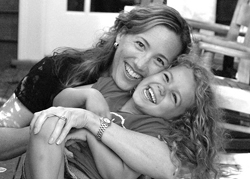According to John Gottman, one of my all-time favorite researchers, emotion-coaching is the key to raising happy, resilient, and well-adjusted kids. His research—30 years of it—shows that it is not enough to be a warm, engaged, and loving parent. We also need to emotion coach our kids.
Emotion-coached kids tend to experience fewer negative feelings and more positive feelings. The three steps below are adapted from Gottman’s book Raising an Emotionally Intelligent Child, which I can’t recommend highly enough.

This first step to coping with negative emotions (in yourself, your children, or in your mother-in-law) is to figure out what they are feeling and to accept those feelings. Even if we don’t accept the bad behavior that often accompanies negative emotions, we still want to send the message that all feelings are okay, even the worst ones. Terrible feelings like jealousy and fear and greed are invitations to grow, to understand ourselves better and to become a better person. When you see these “undesirable” emotions in children, think of them as opportunities to both learn more about their inner-world and—importantly—to teach them how to deal with negative emotions now and in the future.
Step One: Label and Validate the Feelings-at-Hand
Before we can accurately label and then validate our children’s feelings, we need to empathize with them—first to understand what it is they are feeling, and then to communicate what we understand to them. This is simple, but not always easy.
Say Molly is feeling bad because she got into some trouble at school for talking too much in class (no idea where she might have gotten that tendency). Kids frequently displace negative emotions onto their loving parents and caregivers, meaning that while Molly might be mad at herself, a classmate, or her teacher, it would be normal for her to displace that emotion onto me when she got home. So when I tell her she can’t have a playdate with Claire right that second, it provokes an angry fury, during which she throws her backpack against the wall I’ve asked her to hang it on and calls her sister a “stupid idiot” she would never want to play with “in a million years.”
Instead of dealing with the bad behavior right away (time out!) this is a terrific opportunity to accomplish the first step in emotion-coaching: validating and labeling the negative emotions.
Me: “Molly, I can see that you are very angry and frustrated. Is there anything else that you are feeling?”
Molly: “I am SO SO SO MAD AT YOU.”
Me: “You are mad at me, VERY mad at me. Are you also feeling disappointed because I won’t let you have a playdate right now?”
Molly: “YES!! I want to have a playdate right NOW.”
Me: “You seem sad.” (Crawling into my lap, Molly whimpers a little and rests her head on my shoulder.)
I’ve now helped Molly identify and label several feelings: angry, frustrated, disappointed, sad. The larger our children’s emotion vocabulary is, the easier it is to label emotions in the heat of the moment. I have also validated how Molly has been feeling: she knows I think it is okay to have felt all those “bad” things. Interestingly, now she is calm, tired—clearly needing a snack and a cuddle.
To continue on to steps two and three, see my post on the Greater Good Science Center.
